Ten years of supercomputing in the arctic region
by Jenn Wagaman, Arctic Region Supercomputing Center
March 2003
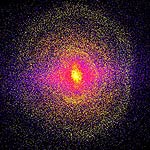
Simulating galaxy formation using the power of ARSC's supercomputers has allowed researchers
to get closer to discovering the age of our universe.
Image courtesy ARSC. 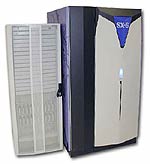
The ARSC Cray SX-6 was the first computer powered by Japanese technology to be installed
in the U.S. This technology is identical to that of the Earth Simulator, a Japanese
supercomputer ranked the fastest in the world. The computer is currently hosted by
ARSC for use by researchers to conduct benchmarking and test their codes.
Image courtesy ARSC.

Visualization specialists at ARSC create images that allow researchers a closer look
at their data. This simulation, created by artist and visualization specialist Bill
Brody, depicts the sun during an extreme solar flare.
Image courtesy ARSC.
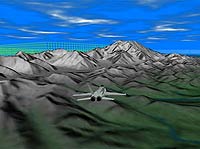
Visualization researchers at the center have created a virtual fly-by program using
satellite data of Alaska terrain. The program will be used to familiarize pilots with
the complex Alaska airspace. A system of colored grids and domes warn the pilots of
flight regulations over villages, towns or even caribou calving grounds.
Image courtesy ARSC.
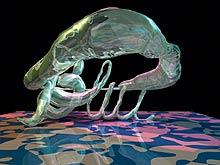
The Body Language User Interface, or BLUI™, is a three-dimensional drawing program
created at ARSC. The program allows researchers to investigate new computer-user interfaces
that will eventually eliminate the need for traditional input devices like the mouse
and keyboard.
Image courtesy ARSC.
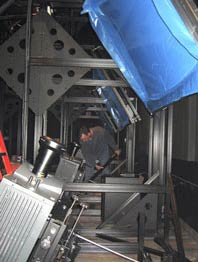
The projectors, mirrors and frames are installed in the Discovery Lab.
Image courtesy ARSC.
Two thousand and three marks the Arctic Region Supercomputing Center's (ARSC) 10th anniversary. Since its opening, the center has grown significantly as an important computational resource for the University of Alaska and the nation. In concurrence with the center's anniversary, ARSC will be conducting significant upgrades to the center's computational, visualization and storage systems. Using the new resources, ARSC users will be able to accomplish tasks like simulating movement through a tsunami and experiencing its run-up, quickly storing and retrieving massive amounts of data and running computations faster than ever before possible.
Supercomputers at ARSC support academic and government scientists who perform work in a variety of research areas. The supercomputers are also available to students for class projects and learning about high performance computing. Areas of research include regional and global climate modeling; ocean circulation and tsunami modeling; proteomics and genomics; the physics of the upper atmosphere; permafrost, hydrology and arctic engineering; volcanology and geology; arctic biology and art.
- ARSC's Total Overall Computational Power and Storage
- Computational Resources
- Visualization Resources
- Storage
- Virtual Reality Upgrades at ARSC
- More Resources
Ten Years of Supercomputing
Since the installation of the first supercomputer, Denali, in 1993, ARSC has grown from one supercomputer to a state-of-the-art high performance computing facility housing five supercomputers as well as storage and visualization resources.
| THEN 4 processors 1.3 gigaflops 8 gigabytes RAM 1.1 terabytes storage |
NOW 544 processors 788 gigaflops 328 gigabytes RAM 330 terabytes storage |
SOON 1472 processors 7 teraflops 3 terabytes RAM 1 petabyte storage |
|
Note: storage here does not refer to disk but rather to the potential capacity of the StorageTek silos. |
bit = 1 byte = 8 kilo = 1000 mega = million |
giga = billion tera = trillion peta = quadrillion exa = quintillion |
Computational Resources
As researchers continue to push ARSC supercomputers to solve important problems in
fields like bioinformatics and global climate change, the center is constantly re-evaluating
its own systems to ensure that those researchers have access to the best computational
resources available. Over the next year, the center will be installing new supercomputers
and retiring old ones, allowing scientists to push their research to new heights.
Read more about ARSC computational resources at http://www.arsc.edu/news/news.html
Visualization Resources
To supplement existing visualization resources, center staff recently installed a Mechdyne MD Flex™ system, which provides a fully-immersive real-time virtual environment. This system will be housed in the UAF Rasmuson Library and will be available to researchers, scientists and students at the university to explore virtual environments and conduct research in areas such as computer-user interfaces, tsunami inundation and the aurora borealis, as well as work in other forms of creative expression like three-dimensional animation.
Read more about virtual reality at http://www.arsc.edu/news/mdflex.html
- Visit our NEW Discovery Lab (Quicktime Panorma 2.1 MB)
- View QuickTime visualizations
Storage
ARSC houses two StorageTek robotic tape silos, which were recently upgraded to allow for 1 petabyte of potential storage (a petabyte is equal to a million million million million bytes). The silos are assisted by two 8-processor Sun Fire™ 6800 systems and one Sun Fire™ 4800 system. The Sun supercomputers are needed to handle the massive amounts of data scientists produce, archive and retrieve each day at ARSC. The additional storage space expanded the center's storage capacity by nearly three and a half times, to nearly 1,000 times the original storage capacity of the center in 1993. Imagine a 600-mile high stack of paper growing to over 600,000 miles.
Read more about ARSC computational resources at http://www.arsc.edu/resources/resources.html
Virtual Reality Upgrades at ARSC
ARSC is proud to announce the arrival of the center's second immersive environment, a Mechdyne MD Flex system. The display and computers arrived just a few weeks ago and are currently being assembled in the UAF Rasmuson Library. The room housing the system will be called the ARSC Discovery Lab. This addition to ARSC's visualization resources will aid ARSC scientists and researchers in visualizing their data in a three-dimensional, immersive environment. The MD Flex is a small room approximately 10' x 10' x 8' in size. Three walls and the floor are equipped to display stereoscopic images, which allow researchers to virtually immerse themselves in their data set. The MD Flex is powered by an SGI Onyx 3200 image generator with four CPUs, four gigabytes of memory, and two Infinite-Reality4 graphics pipes.
The MD Flex system can accomodate several researchers at once, allowing simultaneous viewing of the same data. In the immersive environment, the image generator draws the stereoscopic images based on the perspective of a special tracker worn by the "driver." All other participants wear standard, active or passive 3D glasses, and are able to view the same image drawn from a slightly different perspective.
Possible projects that will take advantage of the new MD Flex system are ARSC's Body
Language User Interface, ionospheric modeling, seismology and tsunami modeling, oceanography
and a new aurora project.
The Discovery Lab will be located in the Rasmuson Library on the Fairbanks campus.
The SGI Onyx 3200 will be located in the Butrovich Building machine room along with
ARSC's other supercomputing systems.
More Resources
- Discovery Lab panoramic image (Quicktime Panorma 2.1 MB)
- The images in this feature story are copyrighted and should not be downloaded without permission. High-resolution images and video are available upon request. Contact Jenn Wagaman, ARSC public affairs coordinator, at wagaman@arsc.edu or (907) 474-8662.
- Quicktime Visualizations:
- Art - This visualization was created by artist Miho Aoki. Aoki works jointly with ARSC and the UAF Art department teaching animation and three-dimensional visualization. (Quicktime Movie 6.9MB)
- MOA - The Northern Simulator of Terrain and Aviation Airspace Restrictions (NorthSTAAR) will be used by military and civilian pilots to familiarize themselves with Alaska's complex airspace. (Quicktime Movie 3.3MB)
- Oceans - A scientist and an artist joined forces to model temperature changes in the Gulf of Alaska in an effort to create a more accurate and easily understandable simulation. (Quicktime Movie 1.7MB)
- Tsunami - Visualizations can help researchers actually look at their data. In this movie, a tsunami caused by the 1964 earthquake rushes up on Kodiak, Alaska. (Quicktime Movie 979K)


